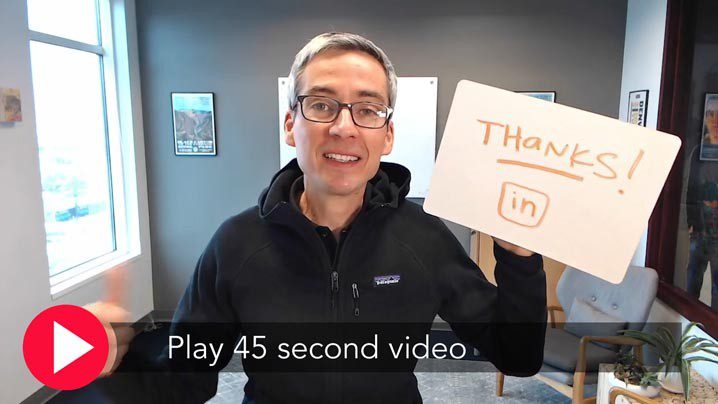
What You Need To Know About Video Selling
Salespeople who previously relied on cold calling, email, and in-person meetings to attract new customers have seen their efforts continue to produce decreasing results for quite some time.
That’s because the traditional methods used to sell and attract new business or take buyers through the sales funnel have become less effective.
If your pipeline is feeling stuck or your team simply isn’t reaching enough prospects or booking enough meetings, it’s time to roll out a strategy for your team to use video for sales.
Creating authentic video messages lets your sales team reach new prospects and stay in touch with current customers while building rapport and trust virtually. Make no mistake about it, sales videos are a game changer for today’s modern salesperson.
Why do videos work
People connect with people when they can relate to them as people. Forming a human connection via email or over the phone is hard. When you create an authentic video message, your prospects and customers can see your facial expressions and hear you speaking directly to them. There’s a human connection that forms without being there in person.
Video messaging allows salespeople to show empathy, cut through the noise of today’s selling environment, and build trust with their prospects and customers. Showing your customers that you are there for them and care about their needs is extremely important.
Video messages help salespeople differentiate from the competition by giving customers an inside look into them as a person while communicating their offerings, benefits, business practices, etc. Their humanity is on full display.
The science behind video
At an unconscious level, our brains respond to what we see as if it were our own experience, whether it’s on TV, the internet, or even a stage.
This is due to what scientists call “mirror neurons.” These neurons cause us to do something when we observe someone else doing it, like smiling or laughing. If someone smiles at you on the street, mirror neurons cause you to smile back.
Our brain does not differentiate between something that we observe on a screen and something that happens in person. This is why people get emotional watching a movie, or they feel like they know a famous person because they feel as though they have been in their personal space through the screen.
Why you should be using video
People are consuming more video than ever before, so adding video to your toolbox of sales communications is critical. Since people are spending more time watching videos, it only makes sense for salespeople to create their own sales videos to reach their buyers through an outlet they may prefer. In addition to meeting your prospects where they are, video:
1. Builds trust faster and more effectively
2. Including a video in an email can improve click rates by a staggering 96%
3. Is accelerating more views in almost every social media algorithm, including LinkedIn
4. Is preferred over text by 59% of senior executives
5. 62% of viewers will watch a business-related video all the way through if it is less than 60 seconds
6. Booking meetings with new prospects increases by 64% when they receive a short video as a first touch
7. Requires nothing more than your smartphone or computer webcam to create
Many salespeople are nervous about recording and sharing videos of themselves. However, you wouldn’t put a bag over your head to walk into a meeting or join a Zoom call, right? So, what’s the difference? Take a deep and just hit record.
How to Use Video in the Sales Process
Video for sales can be used from initial outreach all the way to closing the deal.
Prospecting new customers
As mentioned earlier, prospecting with video allows a salesperson to stand out from the crowd and grab the prospect’s attention. Salespeople can introduce themselves, provide their value proposition, and have a call to action. While most companies are using strategies like SMS integration and email marketing, video has recently gained immense popularity.
Nurturing the relationship
Once a conversation is started, salespeople can nurture the relationship with personalized video messages that add value to the prospect or that help connect at a deeper level. For instance, salespeople can send a video reminder for an upcoming meeting and then a video follow-up after the meeting.
Closing the sale
Salespeople can go beyond shooting off an email with an attached proposal and record a video explaining each point of the proposal and laying out the next steps. It can even be helpful when going over any legal issues and contract details.
Finally, salespeople can create a video thanking the client for their business and introduce them to customer success and other members of the team.
How to Personalize Sales Videos
Create personalized thumbnails. A popular way of personalizing video thumbnails nowadays is to hold a whiteboard and write a message with the prospect’s name.
Use personalized content. Another popular personalization method is to include a screenshot of the prospect’s LinkedIn profile inside the video. This will show that you took the time to research the prospect on LinkedIn and learn more about him or her.
Should you personalize every single video you send? As much as possible, yes, you should. Even if it’s not possible to personalize it to an individual, the video should at least personalize the company or the buyer persona.
Tools for Video
Hosting virtual sales meetings through Zoom is the new normal for salespeople. But as a sales leader, how do you make sure your virtual sales teams look and sound professional?
Video sales engagement platforms. With these tools, salespeople can create and send engaging videos to prospects and clients. They can add filters, create landing pages, receive reports on video views and engagement, and integrate seamlessly into your CRM. The most popular platforms are BombBomb, CoVideo, OneMob, Hippo Video, and Vidyard.
What makes a “good” vs. a “bad” sales video
1. Outreach should always include a CTA (Call to Action). In the video, guide your viewers to take action like clicking on an asset, calling your number, scheduling a meeting, and many more.
2. Keep your video to two minutes or less (for a prospecting video, it should be 1 minute or less) depending on the platform you’re sharing it on; otherwise, you’re bound to lose your viewers’ attention.
3. Create a variety of types of video. This can include invitations to events, informative videos to encourage sign-ups or downloads, video proposal reviews, or quick tips.
How can you accomplish this
If you’re thinking this is a no-brainer, you’re right. It is. But salespeople need to master the art and science of creating and delivering video sales messages. They need to learn to be engaging, authentic, purposeful in their words, and concise. Skills they already possess, such as smiling, being enthusiastic, and always offering a call to action, must be developed for the camera.
I teach B2B salespeople and teams How to Master Video Selling. Reach out to me for more information about modernizing your sales skills and processes.
